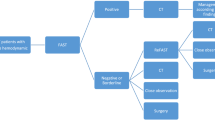Abstract
Focused assessment with sonography for trauma (FAST) is a limited ultrasound examination, primarily aimed at the identification of the presence of free intraperitoneal or pericardial fluid. In the context of blunt trauma abdomen (BTA), free fluid is usually due to hemorrhage, bowel contents, or both; contributes towards the timely diagnosis of potentially life-threatening hemorrhage; and is a decision-making tool to help determine the need for further evaluation or operative intervention. Fifty patients with blunt trauma abdomen were evaluated prospectively with FAST. The findings of FAST were compared with contrast-enhanced computed tomography (CECT), laparotomy, and autopsy. Any free fluid in the abdomen was presumed to be hemoperitoneum. Sonographic findings of intra-abdominal free fluid were confirmed by CECT, laparotomy, or autopsy wherever indicated. In comparing with CECT scan, FAST had a sensitivity, specificity, and accuracy of 77.27, 100, and 79.16 %, respectively, in the detection of free fluid. When compared with surgical findings, it had a sensitivity, specificity, and accuracy of 94.44, 50, and 90 %, respectively. The sensitivity of FAST was 75 % in determining free fluid in patients who died when compared with autopsy findings. Overall sensitivity, specificity, and accuracy of FAST were 80.43, 75 and 80 %, respectively, for the detection of free fluid in the abdomen. From this study, we can safely conclude that FAST is a rapid, reliable, and feasible investigation in patients with BTA, and it can be performed easily, safely, and quickly in the emergency room with a reasonable sensitivity, specificity, and accuracy. It helps in the initial triage of patients for assessing the need for urgent surgery.


Similar content being viewed by others
References
Timothy CF, Martin AC (2000) Abdominal trauma. In: Mattox KL, Feliciano DV, Moore EE (eds) Trauma, 4th edn. McGraw-Hill, USA, p 583
Rozycki GS, Ochsner MG, Schmidt JA, Frankel HL, Davis TP, Wang D et al (1995) A prospective study of surgeon-performed ultrasound as the primary adjuvant modality for injured patient assessment. J Trauma 39:492–8
Ingeman JE, Plewa MC, Okasinski RE, King RW, Knotts FB (1996) Emergency physician use of ultrasonography in blunt abdominal trauma. Acad Emerg Med 3:931–7
Kristensen JK, Buemann B, Kühl E (1971) Ultrasonic scanning in the diagnosis of splenic haematomas. Acta Chir Scand 137(7):653–657
Ascher WM, Parvin S, Virgilio RW (1976) Echographic evaluation of splenic injury after blunt trauma. Radiology 118:411–415
Raum MR, Bouillon B, Eypasch E, Tiling T (1997) Technology assessment of ultrasound in acute diagnosis of blunt abdominal trauma. Langenbecks Arch Chir Suppl Kongressbd 114:461–464
Chiu WC, Cushing BM, Rodriguez A, Ho SM, Mirvis SE, Shanmuganathan K et al (1997) Abdominal injuries without hemoperitoneum: a potential limitation of focused abdominal sonography for trauma (FAST). J Trauma 42:617–622
Bode PJ, Niezen RA, van Vugt AB, Schipper J (1993) Abdominal ultrasound as a reliable indicator for conclusive laparotomy in blunt abdominal trauma. J Trauma 34:27–31
Liu M, Lee CH, P’eng FK (1993) Prospective comparison of diagnostic peritoneal lavage, computed tomographic scanning, and ultrasonography for the diagnosis of blunt abdominal trauma. J Trauma 35:267–270
Branney SW, Wolfe RE, Moore EE, Albert NP, Heinig M, Mestek M et al (1995) Quantitative sensitivity of ultrasound in detecting free intraperitoneal fluid. J Trauma 39:375–380
Chambers JA, Pilbrow WJ (1988) Ultrasound in abdominal trauma: an alternative to peritoneal lavage. Arch Emerg Med 5:26–33
Jehle D, Guarino J, Karamanoukian H (1993) Emergency department ultrasound in the evaluation of blunt abdominal trauma. Am J Emerg Med 11:342–346
Healy MA, Simons RK, Winchell RJ et al (1996) A prospective evaluation of abdominal ultrasound in blunt trauma: is it useful? J Trauma 40:875
Richards JR, Schleper NH, Woo BD, Bohnen PA, McGahan JP (2002) Sonographic assessment of blunt abdominal trauma: a 4-year prospective study. J Clin Ultrasound 30(2):59–67
Adams B, Sisson C (2012) Review: bedside ultrasonography has 82% sensitivity and 99% specificity for blunt intraabdominal injury. Ann Intern Med 157(4):2–12
Fleming S, Bird R, Ratnasingham K, Sarker SJ, Walsh M, Patel B (2012) Accuracy of FAST scan in blunt abdominal trauma in a major London trauma centre. Int J Surg 10(9):470–4
Acknowledgments
No financial grant has been received for this study.
Author information
Authors and Affiliations
Corresponding author
Rights and permissions
About this article
Cite this article
Kumar, S., Bansal, V.K., Muduly, D.K. et al. Accuracy of Focused Assessment with Sonography for Trauma (FAST) in Blunt Trauma Abdomen—A Prospective Study. Indian J Surg 77 (Suppl 2), 393–397 (2015). https://doi.org/10.1007/s12262-013-0851-2
Received:
Accepted:
Published:
Issue Date:
DOI: https://doi.org/10.1007/s12262-013-0851-2




